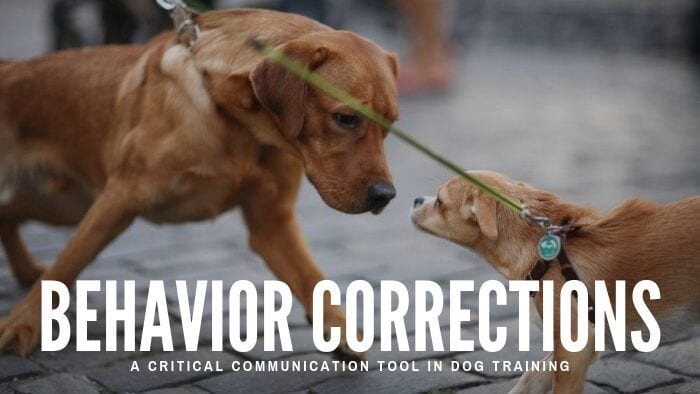How to do corrections in Dog Training. All you have to do is a quick search on the internet to find a sea of people with the opinion that you should never correct your dog…that corrections are abusive and outdated, and that “new methods” of positive reinforcement are the be-all/end-all of dog training. Even current literature outlining the behavioral science of operant conditioning (which is applied to dogs across the board in a way I don’t fully agree with) lean towards telling the reader that modern trainers should avoid corrections. All these people claim that “science” is on their side. Good luck trying to find any of the studies cited in these texts or posts. The “studies” that CAN be found are so fundamentally flawed that it’s a stretch at the least to call them scientific.
“All positive” training is an ideology that has completely taken hold in the dog training industry, much of which is based on an emotional reaction to pressuring dogs and a complete misunderstanding and lack of experience with correction. This is unfortunate, as the truth is both correction and reward have been around as long as people have been training dogs (a very long time), and a mixture of both is still, and always will be, the best approach to a great relationship with our canine companions.
Reward-based training, while a great tool to shape behavior and increase motivation, simply does not produce reliable obedience in the majority of pet dogs when used alone. In fact, using strictly reward based methodology can actually help CREATE behavior problems. Every week I take on new clients that have already been through “all positive” training programs. They spend week after week or even month after month in classes. While the dogs certainly learn commands, most only comply when they want the reward being offered and the client has a pocketful of treats. However as soon as a distraction (competing motivator) is introduced, such as another dog or company at the door, the client dog may as well have never heard a command before. In essence, the dog doesn’t think it has to play the game, and rightly so! In fact, it’s not fair to the dog for us to expect obedience in these scenarios if only reward-based methods have been used. More than one of my clients have had their dogs in classes for up to six months before giving our program a try and the dogs wouldn’t even “come” and “sit” outside, let alone anything else. There is a key differentiator between teaching your dog a trick for a treat and obedience training under distraction. Many of my clients NEED their dogs to obey commands under distraction because their dogs are large and powerful, and otherwise extremely hard to control. The rest simply want to experience the joy of a well-trained dog!
I’m convinced that most positive reinforcement trainers have only the best intentions at heart, yet lack experience and the understanding of corrections. They have been taught that corrections are abusive, and will damage your relationship with the dog. They use terms such as “shock collar”, describing trainers “shocking a dog into submission”. Unfortunately, many “trainers” are also to blame for these misconceptions. They DO use corrective tools this way, which is WRONG on so many levels. However, any tool can be misused, including a leash and collar, or even body language and voice! Again, it comes down to a lack of experience. Take a look at my many before/after videos and you’ll see dogs running to me when released from a command…not the other way around. You don’t see dogs that have been forced to submit…you see dogs that have been taught rules and boundaries through fair communication, and now have MUCH more freedom because of it.
I’m always surprised when debating with treat trainers while how utilizing an eCollar is completely off the table, they are perfectly willing to startle the dogs they train with water bottles, loud noises, or even yelling at the dog. I recently attended an all-day seminar by a world-famous trainer who suggested screaming at the dog while getting on the ground and throwing a tantrum…I’m not kidding here. These people are so against any form of correction that it’s becoming ridiculous. Screaming at a dog or flailing around to startle the dog completely goes against my philosophy. Confidence building is a critical aspect of dog training, and startling a dog can have many unwanted consequences. Doesn’t it sound more reasonable, and clear to the dog, to use small amounts of pressure to communicate what we do not want the dog to do?
A distinction also has to be made when defining correction. A trainer should in most scenarios not be using pressure as a punishment but as a communication tool. The trainer should simply be attempting to elicit the desired response from the dog with pressure being one of several factors of communication during the process. The key here, and this is critical, is the level of pressure. This pressure can come in many forms; spatial pressure, leash pressure, etc. Another form of pressure can be administered through the proper use of an electronic collar. My clients are always surprised by the level of correction we use when working with an electronic collar. In many cases, the clients cannot even feel the level of stimulation we are using when holding the collar in their palms. In many cases what this stimulation equates to is leash pressure. In fact, this is exactly how we use an eCollar much of the time…just like a leash and collar. Think about how much pressure your dog is exerting on the neck while pulling on the leash when taking YOU for a walk. Properly used, the pressure from an eCollar should be nowhere near this level.
Utilizing both reward and pressure, a trainer is able to resolve many behaviors that for most dogs cannot be fixed by tempting the dog with a reward alone. One of the most satisfying aspects of my job is resolving fear/anxiety and aggression issues. Yes, utilizing pressure can and does help resolve anxiety in dogs! I’ve worked with many dogs that have been turned away by all positive training programs, with owners being told that the dog is “untrainable”, or in extreme cases needs to be put down! I understand how these trainers came to that conclusion as they ran out of options when the dog wasn’t interested in the reward being offered in the face of the stimuli that was causing the dog to react. It’s always extremely rewarding to see an owner’s reaction after a session or two with us (in many cases as their last resort due to the misconceptions outlined above) when their dog does a complete 180…in their words transforming into a “completely different dog”!
The benefits of working with both reward and pressure far outweigh any reservations one might have with a good trainer (do your research!) pressuring their dog. A well-trained dog gets to spend more time with the family, even when company arrives! The dog can run around freely in the yard and be recalled with just a word. The dog can travel with the family. The dog can be walked down the street without a head halter forcing the dog away from distractions. All this with no concern from the owner about what may happen if the leash gets dropped. Both the dog and owner can now live happier lives, with the bond between the two becoming that much greater!
Dog training is an art. There are no hidden secrets as many would lead you to believe. Like any art, it is a nuanced skill developed with time, experience, and a true passion for the craft. Knowing how much pressure to use with a dog comes from experience alone, and each dog is different. Dog owners should always seek the help of a professional and never try techniques on their own where mistakes can be made. This is where positive reinforcement shines…you literally cannot mess it up. Don’t get me wrong, good positive reinforcement trainers have spent a lot of time mastering timing, presentation and other critical skills, and many are extremely good at what they do! What I am saying is that you aren’t going to see any negative consequences if these skills are lacking. However, strictly using positive reinforcement confines the trainer to only a small portion of the many tools available. As I stated earlier it’s also not a fair method of communicating with the dog, as the dog is essentially either interested in what you have or not…no obedience has been taught. In the end, the results/obedience achieved with most pet dogs using only positive reinforcement reflect these facts, which is why so many people seek our training after trying these methods.
– Daniel Carter


